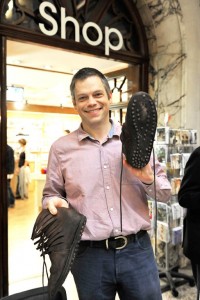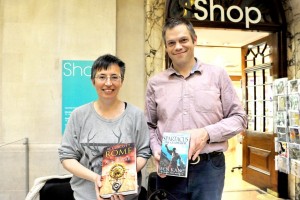Meet the Historians
by Lucienne Boyce
It grew out of a brief conversation with Richard Lee at the HNS 2012 UK Conference. The idea was a simple one: why not bring together local groups of historical experts and writers to explore the connections between history and fiction? So Meet the Historians was born: a programme of events in which academic historians, archaeologists, genealogists, librarians, archivists, and fiction and non-fiction writers gather to discuss making fiction out of history.
Bristol has a lively literary scene so I decided to try out the Meet the Historians format here. The first event was on 27 April 2013 in partnership with Bristol Libraries. Saga writer Lizzie Lane, myself, Local Studies Librarian Jane Bradley and Allie Dillon, Senior Archivist at the Bristol Record Office, offered writers practical advice on researching historical location.
Two more Meet the Historians events were included in the Bristol Literature Festival. From Roman Fact to Roman Fiction on 19 October 2013 featured historical novelists Ben Kane and Manda Scott and museum curator Gail Boyle, with Festival organiser and local historian and novelist Mike Manson in the chair.
The session was part of a programme of activities accompanying the Bristol Museum’s Roman Empire: Power and People Exhibition (21 September 2013 – 12 January 2014), which was curated by Gail. She gave a fascinating talk comparing and contrasting how historical novelists and museum experts weave stories around objects.
Ben Kane is the author of novels about Spartacus, Hannibal and first-century BC Rome. He told us about his recent walk along Hadrian’s Wall, wearing full Roman military kit. This included hobnailed boots – which he brought with him! The walk raised almost £19,000 for charity.
Manda Scott’s international best-selling Boudica series explores who we were before the Romans came, while her Rome series of first-century spy thrillers dissects the early Empire and the men and women who were key to its evolution. Manda’s talk explored “how fiction writers can expand on history, and explore the places historians dare not tread.”
Bristol has a rich maritime heritage and it was appropriate that the third event – The Best Port of Trade in Britain: Bristol’s Maritime History – was held at the M Shed Museum overlooking the water. In a session chaired by Andy King, Senior Collections Officer for Industrial & Maritime History, novelist Julian Stockwin and I joined historians Adrian Tinniswood and Dr Steve Poole.
Adrian Tinniswood has recently published Pirates of Barbary, Corsairs, Conquests and Captivity in the 17th-Century Mediterranean (Jonathan Cape, 2010) and The Rainborowes: Pirates, Puritans and a Family’s Quest for the Promised Land (Cape, 2013). His talk focussed on the terrifying Barbary pirates, who carried out slaving raids in Ireland, off the Devon and Dorset coasts, along the Thames, and around Bristol.
Dr Steve Poole is Associate Professor of Social and Cultural History at the University of the West of England, and editor of and contributor to A City Built Upon the Water: Maritime Bristol 1750-1900 (Redcliffe Press, 2013). He encouraged historical novelists not to rely exclusively on books when researching: “get into record offices!”
My own novel, To The Fair Land (Silverwood Books, 2012) centres on a voyage from Bristol to the South Seas in the eighteenth century. I spoke about some of the research sources I used when writing the novel, and in particular how walking around historical sites and looking at paintings and objects can enhance a writer’s research.
Julian Stockwin is the author of the Kydd novels set in the Great Age of Fighting Sail. He described the Bristol sugar trade, which relied on slave labour in the Caribbean. Sugar meant wealth, and shipping it back to Britain was a perilous undertaking in privateer-patrolled waters. Julian enlivened his talk by producing various nautical objects, including a ship’s block, a beer tankard, a flintlock pistol and a blood-curdling cutlass!
If you’d like to organise a HNS Meet the Historians event in your area, contact Richard Lee for more information.
About the contributor: Lucienne Boyce’s historical novel, To The Fair Land (2012) is an eighteenth-century thriller set in Bristol and the South Seas. This year she published The Bristol Suffragettes (non-fiction). She is currently working on a novel about a Bow Street Runner who is sent to Somerset in 1796 to investigate murder, riot and arson in the wake of a land enclosure. More at www.lucienneboyce.com
Photo credits: Paul Bullivant, Bristol Festival of Literature
______________________________________________
Published in Historical Novels Review | Issue 67, February 2014








